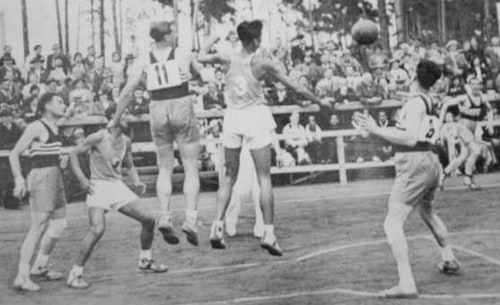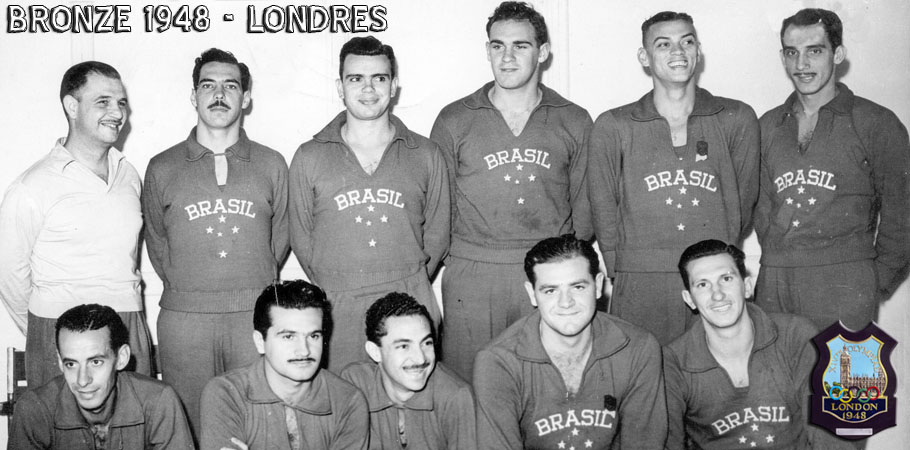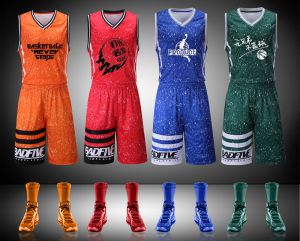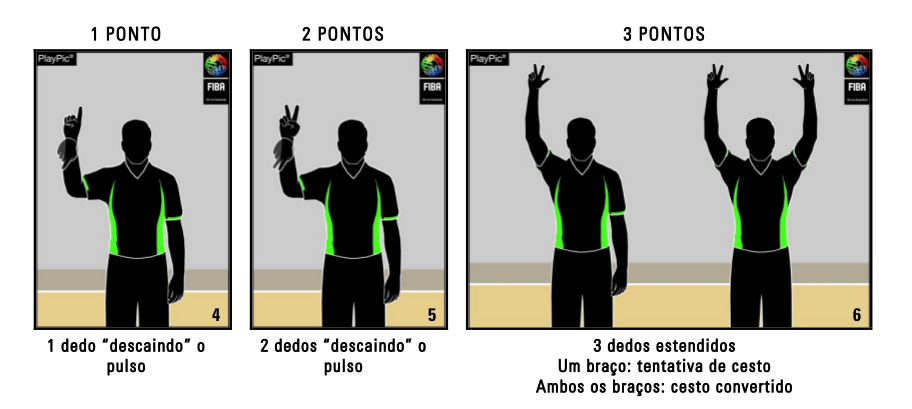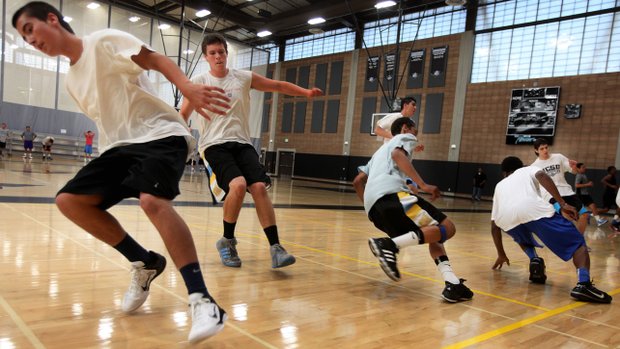Introduction: History, Rules and Fundamentals of Basketball
O Physical Education Tips has prepared a special summary with everything you need to know about the History, Rules and Fundamentals of Basketball.
ORIGIN OF BASKETBALL
WHO CREATED BASKETBALL
Basketball was created by James Naismith, the son of two Scottish immigrants to Canada, who taught physical education at the YMCA in Springfield, USA.
WHERE, WHEN AND HOW BASKETBALL CAME ABOUT
Basketball emerged in Springfield in the United States in 1891, where James Naismith taught Physical Education. The Director of Physical Education, Dr. Luther Gulick, asked James Naismith to create a new game that students could play indoors during the winter, to keep the athletes active, and that was safe, i.e. with little physical contact to avoid injuries.
THE INSPIRATION FOR THE CREATION OF BASKETBALL
James Naismith had two weeks to devise the new sport, inspired by a game he had played as a child, “Duck on a Rock“, where a duck was placed on a rock or tree and the players had to throw stones at it to try and knock it off.
THE HISTORY OF THE BASKETBALL AND THE BASKET
 Instead of using a stone, James Naismith decided to use a soccer ball. The aim of the game would be to hit the soccer ball into a peach basket, which would be nailed to the wall.
Instead of using a stone, James Naismith decided to use a soccer ball. The aim of the game would be to hit the soccer ball into a peach basket, which would be nailed to the wall.
Both the choice of a soccer ball (instead of stones) and placing the peach basket high up were designed to prevent injuries.
“Curiosity of Basketball History
The peach baskets used in the first basketball games were not hollowed out, so whenever someone hit the ball into the basket, the game would stop and someone would grab a ladder and pull the ball out of the basket. Two years later, in 1893, an iron hoop and a net were used, but the net was not hollowed out and the ball remained stuck in the basket every time someone hit it.”
DRIBBLING WAS FORBIDDEN AT THE ORIGINS OF BASKETBALL
In the early days of basketball, dribbling (bouncing the ball) was not allowed, the ball was just passed between the players, whoever had the ball had to remain still. This rule was also intended to prevent contact, clashes between players and injuries.
THE FIRST BASKETBALL MATCH IN HISTORY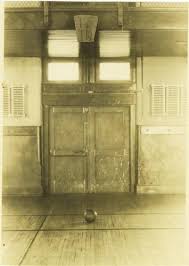
The first game in basketball history took place on December 21, 1891. Each team played with 9 players and the match was played in two 15-minute halves. The final score was 1-0, the only point of the game being scored by William R. Chase.
James Naismith’s account of the first basketball game in history
“When Mr. Stubbins brought the peach baskets to the gym, I took them and fixed them 3 meters off the ground. One on each side of the court. I posted the 13 rules on the bulletin board, held up a soccer ball and waited for the class to arrive. They weren’t very excited, but they followed my instructions. I put the ball into play and tried to stick to the rules. Most of the fouls were for running with the ball. That was the start of the first basketball game.”
CURIOSITIES RELATED TO THE HISTORY OF BASKETBALL
- Another difference between the first game of Basketball and the current game is that after a successful basket, the ball was taken back to the center of the court for the game to be restarted with the ball in the air.
- James Naismith didn’t believe that there was anything to coaching and that it was better to let the players play. He even tried to convince one of his former players, the famous coach Forrest “Phog” Allen. When Allen told Naismith he was going to coach, Naismith told him,“You can’t coach basketball; you just play.” Forrest Allen went on to prove Naismith wrong, becoming one of the great coaches in basketball history.
- The name James Naismith is in the Basketball Hall of Fame: The Naismith Memorial Basketball Hall of Fame. It is located in Springfield, MA, USA, the city where basketball was invented.
- James Naismith died in 1939 of a cerebral hemorrhage.
BASKETBALL AT THE OLYMPIC GAMES
- In 1904, basketball took part in the Olympic Games as a demonstration sport
- In 1936, basketball was officially an Olympic sport at the Berlin Games.
- James Naismith was taken to Berlin, threw the ball at the start of the first Olympic basketball game and took part in the medal ceremony.
- Naismith died just three years after seeing basketball at the Olympic Games.
Millionaire Rules
The document on which James Naismith wrote the original 13 rules of basketball was sold in 2010 for 4.3 million dollars.
Naismith could never have imagined that 119 years later, that piece of paper on which he wrote would be worth so much money.
THE HISTORY OF BASKETBALL IN BRAZIL
The history of basketball in Brazil began with the American Augusto Shaw, who came to Brazil in 1896 to teach art at the Mackenzie College in São Paulo.
Shaw brought with him a basketball, a sport that had been created in 1891 by James Naismith.
THE FIRST BASKETBALL PLAYERS IN BRAZIL
In the beginning, women were the ones who most identified with and practiced Basketball, which led to a macho resistance and men ended up opting for Football. But soon basketball also became popular with men and Augusto Shaw sent a photo of the first basketball team to the United States.
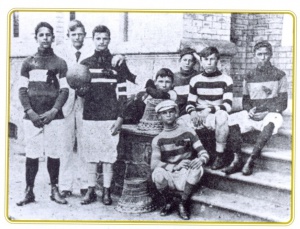
THE FIRST BASKETBALL TOURNAMENT IN BRAZIL
It was in Rio de Janeiro, in 1912, at the Gymnasium on the famous Rua da Quitanda that the first basketball tournament in Brazil took place.
THE FIRST BRAZILIAN BASKETBALL TEAM
In 1922, a Brazilian basketball team was called up for the first time to compete in a tournament with the Uruguayan and Argentinian teams, in which Brazil won.
In 1930, the Brazilian basketball team took part in the first South American Basketball Championship in Montevideo, Uruguay.
In 1936, the Brazilian men’s basketball team took part in the Olympic Games in Berlin and came ninth.
CREATION OF THE BRAZILIAN BASKETBALL FEDERATION
On December 25, 1933, the Brazilian Basketball Federation was created. In 1941, a meeting approved the name change to Brazilian Basketball Confederation (CBB).
TITLES IN THE HISTORY OF BRAZILIAN BASKETBALL
- In 1948, Brazil’s men’s team won a Bronze medal at the London Olympics
- In 1959, the Brazilian men’s team won the World Basketball Championship
- In 1960 another Bronze medal for the men’s team
- In 1963, the boys from Brazil won the World Cup twice
- In 1964, another bronze medal for the Brazilian men’s team at the Tokyo Olympics.
- In 1971, the WOMEN ‘S team won third place in the World Basketball Championship held in Brazil.
- In 1987 the men’s team beat the United States in the Pan American Basketball Championship
- In 1991, Brazil’s girls won the Pan American Championship in Havana.
- In 1994, Brazilian women’s basketball became world champions
- In 1996 the girls won a silver medal at the Olympic Games in Atlanta.
- In 2000, the girls again won a bronze medal for Brazil at the Sydney Games.
About Augusto Shaw
Augusto Shaw lived in Brazil until 1914 and was able to follow much of the spread of basketball in Brazil. He died in 1939 in the United States.
1 – WHAT IS THE GAME OF BASKETBALL?
Basketball is a team sport played by two teams of five players each.
1.1 – WHAT IS THE AIM OF THE GAME OF BASKETBALL?
The aim of the Basketball game is to score points by throwing the ball into the basket defended by the opposing team.
2 – WHAT ARE THE MEASUREMENTS AND DIMENSIONS OF THE BASKETBALL COURT?
According to the Basketball Rules, a basketball court is 28 meters long by 15 meters wide.
2.1 – THE LINES OF THE BASKETBALL COURT
All the lines on the basketball court are 5 centimetres wide and must be painted white.
2.2 – BASKETBALL COURT BOUNDARY LINES
The boundary lines of the basketball court are the side lines and the end lines. The boundary lines are not part of the basketball court.
2.3 – HOW HIGH IS THE BASKETBALL HOOP?
- The Basketball Basket (hoop) is 3.05 meters off the ground
- The basketball court is 2.90 meters above the ground
- The diameter of the basketball hoop is 45 centimeters.
2.4 – IMPORTANT BASKETBALL COURT MEASUREMENTS
-
The center circle of the basketball court has a radius of 1.8 meters
-
The semicircle of the Free Throw area has a radius of 1.8 meters
-
The Free Throw line is 3.6 meters long and is marked 5.8 meters from the end line
-
The restricted area (Garrafão) is a rectangle 5.8 meters long by 4.9 meters wide that lies between the end line and the Free Throw line.
-
The measure of the 3-point line in Basketball is an arc with a radius of 6.75 meters measured from the center of the basket
-
The offensive no-load semicircle is marked at a radius of 1.25 meters from the center of the basket.
3 – WHAT EQUIPMENT IS USED IN A BASKETBALL GAME?
The basic equipment for a game of basketball is abasketball court with a hoop and a stand, a basketball, a stopwatch and a scoreboard to mark the score and fouls.
4 – HOW MANY PLAYERS MAKE UP A BASKETBALL TEAM?
-
A basketball team is made up of a maximum of 12 players, with 5 on the court and up to 7 reserves.
-
A coach, an assistant coach and up to 5 members of the coaching staff
5 – THE BASKETBALL PLAYER’S UNIFORM CONSISTS OF:
-
T-shirt with the same dominant color on the front and back
-
Shorts below the knee with the same dominant color on the front and back, but not necessarily the same color as the shirt
-
Sock of the same dominant color for all players
6 – WHAT IS THE ROLE OF THE CAPTAIN OF A BASKETBALL TEAM?
The captain of a basketball team is the coach’s representative on the court and can address the referee respectfully to request information when the ball is out of play.
7 – WHAT IS THE ROLE OF THE COACH OF A BASKETBALL TEAM?
-
give the scorer a list of the names and numbers of your team’s players at least 20 minutes before the start of the match
-
Stand and talk to your players without leaving the bench area
8 – HOW LONG DOES A BASKETBALL MATCH LAST?
A basketball match is divided into 4 periods of 10 minutes each. If at the end of the last quarter the game is tied, there will be a 5-minute overtime and as many as necessary until the game has a winner.
9 – BASKETBALL RULES
-
Bola Viva: It’s when the ball is in play
-
Dead ball: This is when the ball is out of play
-
Ball in the air: applies at the start of the game and when there is a trapped ball (when two or more opposing players are holding the ball at the same time).
-
The Ball in the Air also applies when:
-
The ball leaves the court and the referee is unsure which team should replace it
-
At the start of each period
-
Double foul on the last free throw
-
If the ball gets stuck between the hoop and the table
-
9.1 – ALTERNATING POSSESSION IN BASKETBALL
Alternate Ball Possession is a procedure that replaces the Ball in the Air.
Procedures for Altered Ball Possession:
-
The team that loses the first Ball in the Air will be entitled to the first Alternate Ball Possession
-
The team entitled to the next alternate possession at the end of any period will start the next period
9.2 – BALL HANDLING IN BASKETBALL
During the game of basketball, the ball can only be touched with the hands. It can be passed, rolled, thrown or bounced.
Basketball is not allowed:
-
Running with the ball
-
Kicking the ball
-
Hit the ball with your fist
-
Intentionally intercepting the ball with any part of the leg
“Unintentionally touching the ball with your leg is not a violation of the rule.”
10 – HOW MANY POINTS A BASKET IS WORTH IN BASKETBALL
- A free-throw basket is worth 01 point
- A converted basket in the area bounded by the three-point line is worth 02 points
- A converted basket outside the 3-point line is worth 03 points
Is there an own goal in basketball?
“According to the Rules of Basketball, if a player converts a basket into his own hoop (basket against) unintentionally, 02 points will be scored for the captain of the opposing team. But if the basket against is intentional, the point will not be valid.”
11 – BALL REPLACEMENT IN BASKETBALL
In basketball, the ball is replayed outside the boundaries of the court and in the place closest to where the infraction occurred. The referee must give the ball to the player who is going to replace it. The player will have 5 seconds to make the rebound.
Other ball replacement situations in basketball:
- After a converted basket, the replacement must be made behind the back line
- At the start of each period or after a free throw resulting from a technical, unsportsmanlike or disqualifying foul, the ball shall be replayed on the center line of the court, outside the court.
- If a basket is converted but not validated, the replacement takes place outside the court at the free-throw line
12 – TIME OUTS IN BASKETBALL
A time-out in basketball is an interruption in play requested by a team’s coach and lasts one minute.
Each team is entitled to:
- 02 time-outs in the first half (first and second periods)
- 03 time-outs in the second half of the game, with a maximum of two time-outs allowed in the last two minutes.
- 01 time request for extra time
13 – HOW ARE SUBSTITUTIONS MADE IN BASKETBALL?
- When the ball is out of play, the timer is stopped and the referee has finished communicating with the control desk.
- When a player receives the ball to make a substitution, they are no longer allowed to make a substitution.
- The substitute player must inform the control table that a substitution is about to take place.
14 – MATCH LOST DUE TO ABSENCE OR EXCLUSION
- A team forfeits a match for absence if it does not have 05 players fit to play within 15 minutes of the scheduled start time.
- A team loses the game by exclusion if during the game it is reduced to less than 02 players able to play.
15 – VIOLATIONS OF BASKETBALL RULES
Whenever there is a violation of the rules of basketball, the ball must be awarded to the opponent for replay outside the court from the place closest to where the violation occurred.

Types of violations (infractions) of basketball rules:
- Player or ball out of court (player or ball is considered out of court when it comes into contact with the ground, object or person outside the court)
- Player dribbles twice in a row
- Player walking with the ball
- Player remains more than 3 seconds inside the opponent’s restricted area (Garrafão) when his team has possession of the ball
- Player holds the ball for more than 5 seconds
- Remaining in possession of the ball for more than 8 seconds on the defense court
- Not making a shot at the opponent’s basket within the 24-second time limit
- Return the ball from the attacking court to the defending court

“A player in the defense zone may not interfere with an opponent’s shot that is on a downward trajectory, nor touch the rim or the basket, if this occurs, a point will be awarded to the opposing team according to the position or situation in which the shot was taken.”
15 – FOULS IN BASKETBALL
Fouls are infractions of the rules of basketball relating to physical contact or an unsportsmanlike attitude.

15.1 – LEGAL DEFENSE POSITION
A player is in a legal defensive position when he is facing his opponent, with his feet on the ground and occupying a cylindrical space.
It’s considered a foul in basketball:
- Causes contact with an opponent who is in a legal defensive position (attacking foul)
- Blocking or obstructing an opponent from their legal defensive position
- Charging(pushing) the opponent
- Touching the opponent with your hands, restricting their movements
- Grabbing the opponent anywhere on the body
15.2 – TYPES OF FOUL IN BASKETBALL

- Personal foul: illegal physical contact with the opponent
- Double foul: this is when two opposing players commit a personal foul at the same time. The foul will be noted by the table and the game will restart normally without any penalty for the teams.
- Technical foul: is marked by inappropriate behavior on the part of the team’s players or coaching staff.
- A player who commits two technical fouls will be disqualified from the game
- If a technical foul is committed by a player, it counts as both an individual and a team foul
- If committed by a member of the bank, it will not count as a collective fault
- The opposing team will be awarded a free throw plus ball replacement
- Unsportsmanlike Foul: is an intentional foul that violates the spirit of the rules of the game.
- A player who commits two unsportsmanlike fouls will be disqualified from the game
- free throws will be awarded to the opposing team.
- If the foul was committed on a player who was not shooting, the team is entitled to 2 free throws.
- If the foul was committed on a player who was in the act of shooting, the shot will be converted and the team will have 1 more free throw.
- Disqualifying Foul: is an explicitly unsportsmanlike foul.
- The player will be disqualified
- If the foul was committed on a player who was not in the act of shooting, the team will be entitled to 2 free throws plus ball replacement
- If the foul is non-contact: 2 free throws
- If a foul is committed on a player in the act of shooting: the basket is converted and, in addition, 1 free throw.
- If a foul is committed on a player in the act of shooting and the basket is not converted: 2 or 3 free throws depending on the position of the shot.

“According to the Rules of Basketball if a player commits 5 fouls he must be informed by a referee and must leave the game immediately. He must be substituted within 30 seconds.”
15.3 – TEAM ABSENCES
A team foul is any personal, technical, unsportsmanlike or disqualifying foul committed by a player.
A team incurs a team foul penalty when it has committed 4 team fouls in a period.
When a team incurs ateam foul penalty, all subsequent personal fouls committed by its players on an opponent who is not in the act of shooting must be penalized with 2 free throws instead of a ball replacement.
Extra: Video on the Rules of Basketball
INTRODUCTION: THE FUNDAMENTALS OF BASKETBALL
After all, what are the main fundamentals of basketball? The main fundamentals of basketball are
- Body control
- Ball handling
- Dribbling, Passing
- Throwing
- Tray
- Jump
- Rebounding
Below is a summary of all the basic fundamentals of basketball.
BODY CONTROL IN BASKETBALL
Body Control or Body Handling is very important for performing basketball movements.
Body control is important in both defensive and attacking movements and should not be overlooked in introductory basketball classes.
Some Body Control movements that should be practiced in basketball are:
- Cute
- Fintas
- Races with multiple changes of direction
- Front running, back running and side running
- Sudden stops (stopping abruptly after a run to make it more difficult for the opposition to score)
BALL HANDLING IN BASKETBALL
Ball Handling is the Basketball Fundamentals that aims to develop the ability to Control the Ball in different situations.
Some Ball Handling movements that should be practiced in Basketball are:
- Roll the ball
- Bounce the ball
- Holding the ball
- Changing hands
- Throw the ball from one side of the body to the other over the head
- Throw the ball from the back to the front of the body over the head
- Throwing or passing the ball between the legs
- Pass the ball around your body (at knee height and waist height)
DRIBBLING IN BASKETBALL
Dribbling is one of the most used basketball fundamentals during a game. It’s the act of bouncing the ball with one hand.
Dribbling is used so that the basketball player can move with possession of the ball.
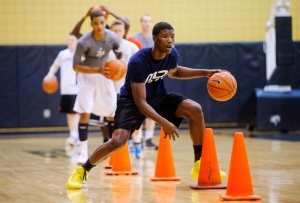
A simple tip that should always be observed when dribbling is that the dribbling player should always keep the opposite leg of the dribbling hand forward:
- Dribble with your right hand, left leg in front.
- Dribble with left hand, right leg in front.
WHAT ARE THE TYPES OF DRIBBLING IN BASKETBALL?
1 – High Dribble ⇒ Also called the Speed Dribble, as it is used when the basketball player is unmarked and can move at speed.
In High Dribbling, the ball is propelled further in front of the body.
2 – The Low Dribble ⇒ Also called the Protection Dribble, because this type of dribble is used when there is a marker close to the player who has the ball, so he needs to dribble to protect the ball from his marker. In this type of dribbling, the legs bend more and the ball is always protected by the player’s body.
TIPS FOR DRIBBLING
- Always dribble with your head up (looking at your marker and the movement of the other players)
- Dribble by pushing the ball down (don’t hit the ball)
- During the dribble, don’t let the ball rise beyond waist height
WHAT IS DRIBBLING FOR?
- To disengage from a marker
- To adjust the position of the body for a throw-in or pass
- To protect the ball in front of a marker
- To move at speed with the ball
BASKETBALL FUNDAMENTALS: PASSING
Passing in basketball is the act of throwing the ball to a player on the same team. It is an attacking skill used to move the team.
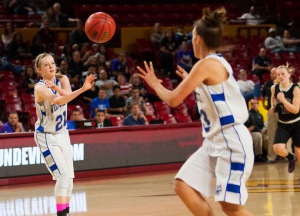
WHAT ARE THE TYPES OF PASS IN BASKETBALL?
1 – The Chest Pass ⇒ The Chest Pass is the most common type of pass in Basketball, it is a pass for short and medium distances, it is a quick pass and the ball follows a straight trajectory.
2 – The Chopped Pass ⇒ The Chopped Pass in basketball is used over short distances. In this type of pass, the ball touches the ground before reaching the teammate.
3 – The Over-the-Head Pass ⇒ The Over-the-Head Pass in Basketball is made over short distances by throwing the ball over the marker.
4 – The Shoulder Pass ⇒ The shoulder pass in basketball is used to reach long distances. It is often used in counter-attacking plays, when you want to make a long pass to catch the opponent’s defense off guard.
“Unlike handball, the shoulder pass in basketball is made with both hands.”
5 – The Hook Pass ⇒ The hook pass in basketball is used over long distances and is a type of pass with little precision.
BASKETBALL FUNDAMENTALS: SHOOTING
Shooting in basketball is an attacking action aimed at making a basket (points).
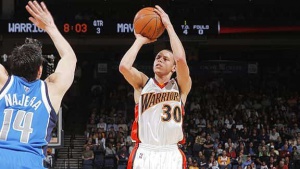
WHAT ARE THE TYPES OF SHOTS IN BASKETBALL?
1 – One-handed shot ⇒ This is the most common type of shot in basketball. It is made by placing the main hand under the ball and the other hand on the side for support. The ball must be thrown into the basket using only the hand under the ball. The one-handed shot can also be made with a jump shot.
TIPS FOR THROWING WITH ONE HAND:
-
If you throw with your right hand, your right leg should be slightly forward, the same goes for throwing with your left hand
-
Bend your legs a little at the start of the throw
-
The elbow of the throwing hand should be pointing towards the basket.
-
Look at the basket
-
Flex the wrist at the end of the throw
-
Throw ball on a parabolic trajectory
SHOOTING IN BASKETBALL
The Tray is one of the most common basketball fundamentals. It is a type of shot made on the move, close to the basket and with a jump.
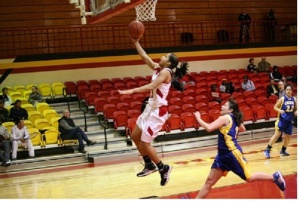
WHAT ARE THE TYPES OF TRAY IN BASKETBALL?
Tray with possession ⇒ This is when the player comes dribbling, approaches the basket, holds the ball, takes two steps and jumps towards the basket, shooting the ball.
Tray without possession ⇒ This is when the player receives the ball near the basket and makes the Tray without dribbling.
THE JUMP SHOT IN BASKETBALL
The jump shot is a type of basketball shot made with a jump. The Jump can be made while moving or standing still and the ball must be thrown at the moment the player reaches the highest height in the jump.
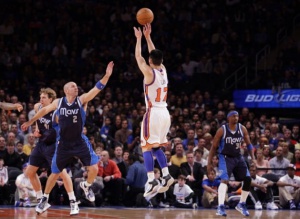
REBOUNDING IN BASKETBALL
Rebounding in basketball is the act of catching the ball after an unconverted shot.
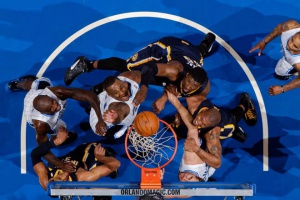
WHAT ARE THE TYPES OF REBOUNDS IN BASKETBALL?
Defensive rebound ⇒ Also called a defensive rebound, this is when a player from the defending team takes the rebound after an unconverted shot from the opposing team.
Offensive Rebound ⇒ Also called an Attack Rebound, this is when a player from the attacking team takes the Rebound after an unconverted Throw-in from their own team.

